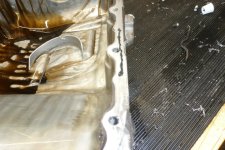Yikes (Per Wiki)
"..Hexagonal BN (h-BN) is the most widely used polymorph. It is a good lubricant at both low and high temperatures (up to 900 °C, even in an oxidizing atmosphere). h-BN lubricant is particularly useful when the electrical conductivity or chemical reactivity of graphite (alternative lubricant) would be problematic. In internal combustion engines, where graphite could be oxidized and turn into carbon sludge, h-BN with its superior thermal stability can be added to engine lubricant, however, with all nano-particles suspension, Brownian-motion settlement is a key problem and settlement can clog engine oil filters, which limits solid lubricants application in a combustion engine to only automotive race settings, where engine re-building is a common practice..."

